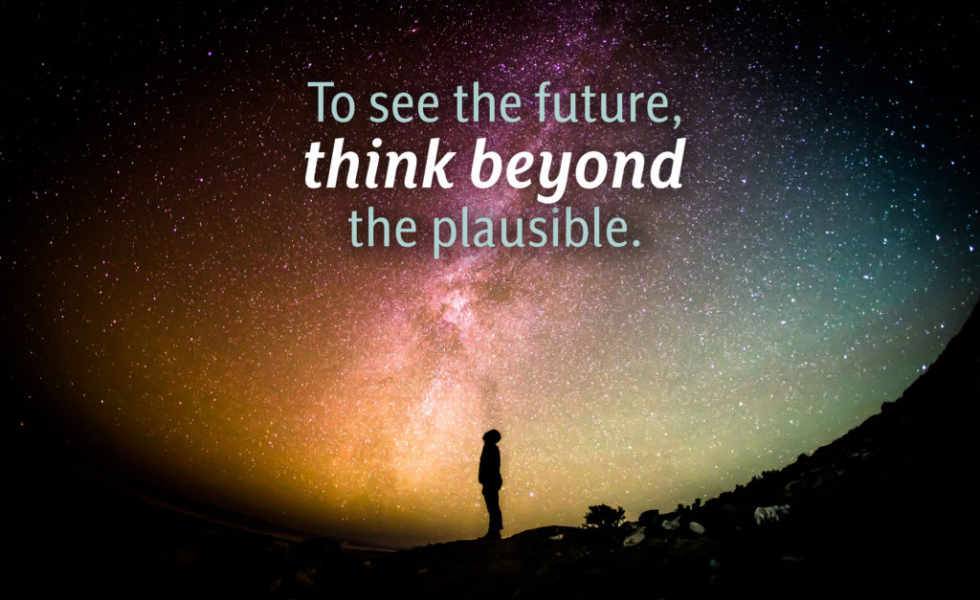Why “That’s Crazy” Is Critical To Good Strategic Foresight

As a younger version of myself, one of the first foresight ideas that I encountered was the popular expression from futurist legend Jim Dator:
“Any useful idea about the future must appear to be ridiculous.”
When sharing this concept with clients from many different industries and sectors, I often begin by telling them that my first reaction to this phrase was probably the same as the one they are presently experiencing: “The only idea that is ridiculous is this saying!”
But in time, I learned that impactful foresight must indeed inhabit the realms of ridiculous thought.
I now – with straight face intact – tell my business, nonprofit and government agency clients that they should definitely be investigating not only the obstacles and opportunities connected to aging populations, shifting demographics or privacy concerns, but also the more “extreme” issues such as human/robot relationships, off-planet expansion, multi-gender identities or dreamscaping.
The latter set initially gets one or two “that’s crazy” comments from the crowd, as well as a few stares that suggest that I might have two heads. However, for many reasons, the more provocative ideas tend to be much more powerful as maps to success than the more obvious or relatable set of trends.
You see, truly provocative future ideas and scenarios—those that have a connection to emerging ideas and events, as well as ideas that exist somewhere on the horizon—stretch our thinking as if it were a rubber band, “pulling” it beyond our limits of comfort. When this happens, it does not mean that we will retain the extreme position experienced during the pulling. However, just like the rubber band, most of us will not return to our former shape. Rather, we will find our thinking at least slightly expanded.
When we hear about trends and ideas that we are comfortable with, they tend to reinforce what we already know, and this fails to challenge our thinking around possible threats and transformations.
When we hear about ideas that make us uncomfortable or that sound “ridiculous” – even when we reject those ideas – we are opened up to thoughts about how those ideas might apply to us as an organization or individual, whether consciously or subconsciously.
And this is where the true power of ridiculous ideas can be seen: provocative thinking allows us to imagine the points on the map between our present actions and those crazy tomorrows.
For instance, I might explain to you that scientists are toying with the idea of capturing our memories by micro-slicing our brains (after death, of course) and then downloading the biological material that contains these mental pictures via DNA-based computing or some form of nanobiotechnology to produce a form of brain preservation or “digital immortality.”
Pretty crazy concept for most of us, right?
But when this idea is viewed in light of the unfolding values behind it, the technology that is being developed to create it or the implications it would have on human thought and activity, then what was previously nothing more than a ridiculous idea begins to have a direct impact on our present strategies, structures and innovations.
Now, what if we were to go one step further and connect the dots between the environment we know today and the landscape of that provocative future? It is in this exercise that we begin to discover and leverage the emerging values, technologies, designs and opportunities that are two or more steps beyond the mundane issues that can be found on a million “Top 10 Trends” lists at the end of every year.
Now we are equipped to identify those significantly disruptive “things we don’t know that we don’t know” without having to completely buy into the most extreme version of the original emerging idea. Even if the ridiculous future never manifests, its nascent values and technologies are well underway.
Without having considered the provocative future, we would never have also considered the futures between our familiar today and the very unfamiliar tomorrows. Suddenly, thinking ridiculously doesn’t seem quite so ridiculous after all.
So, next time you’re inclined to rely upon benchmarking, consumer insights and business intelligence as your means to navigating a world of rapidly accelerating change, stop and tell yourself, “that’s a truly ridiculous idea!”

Frank Spencer
Co-Founder
Creative Director
In 2009, Frank founded Kedge – a global foresight, innovation, and strategic design firm which pioneered TFSX. Throughout his career, Frank has worked as a leadership coach and developer with entrepreneurs, social communities, networking initiatives, and SMEs, helping them in areas such as development, innovation, and networking.
Read More
